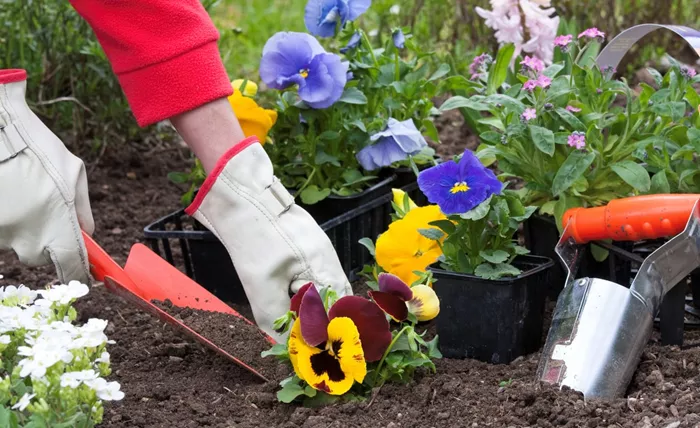Pansies are the perfect flowers to brighten up your garden in spring and fall. These colorful, heart-shaped blooms thrive in cooler weather and are easy to grow—even for beginners.
Viola x wittrockiana, commonly known as pansies, are loved for their cheerful appearance and rich colors. From deep purples to sunny yellows and brilliant bi-colors, they bring life to flower beds and containers alike. According to expert gardeners, now is one of the best times to plant them—and with the right care, pansies will continue to bloom beautifully for months.
A Flower That’s Easy to Love
“Pansies are not high maintenance,” says Nathan Heinrich, a horticulturist and landscape designer with more than two decades of experience. “With just a little effort, they’ll reward you with nonstop color.”
Brock Ingham, owner of the gardening site Bigger Garden, agrees. “They’re resilient and perfect for early spring, when most other plants are still dormant,” he says. He also recommends planting a second round in late summer so they’re ready to bloom again after winter.
1. When and Where to Plant Pansies
The Right Season
The best time to plant pansies is in early spring or fall. Ingham plants them as soon as the soil can be worked in spring, and again in late summer to give them a head start before winter. This two-season approach ensures an extended blooming period.
The Ideal Location
Pansies grow best in spots with morning sunlight and afternoon shade. Avoid planting them in places with intense heat or high humidity, which can weaken the plants. In garden beds, space pansies about 6 to 12 inches apart. For containers, use:
- 6- to 8-inch pots: 1–2 plants
- 10- to 12-inch pots: 3–4 plants
- 14- to 16-inch pots: 5–6 plants
2. How to Choose the Best Pansies
At the garden center, look for plants with more buds than open blooms. These will flower longer after planting. Choose compact, bushy plants rather than tall, leggy ones.
Popular varieties include:
- Majestic Giants – Large, bright flowers
- Matrix Series – Better for warm areas
- Delta Series – Great for cold climates
3. Understanding Pansies: Annual, Perennial, or Biennial?
Though pansies are technically short-lived perennials, most gardeners grow them as annuals because they lose strength after their first year. In areas with mild winters, they can also be grown as biennials, blooming again in spring if planted in the fall.
4. What Pansies Need to Grow Well
Temperature
Pansies thrive in cooler weather—ideally between 40°F and 60°F. They prefer partial sunlight, though newer types can handle more sun. Freezing temperatures below 40°F may harm or kill them.
Soil Conditions
Pansies grow best in slightly acidic to neutral soil (pH 6.0–7.0). The soil should be rich in nutrients and well-drained. “I always test the pH and prepare the soil to be moist and loose before planting,” says Ingham.
Watering
Pansies need even moisture to flourish. Water when the soil feels nearly dry—but avoid soaking it. “In winter, you may not need to water as often,” says Heinrich. “But when you do, water deeply.”
5. Fertilizer and Flower Care
Pansies grow well in nutrient-rich soil, but a little fertilizer helps boost blooms.
- Use a slow-release fertilizer like Osmocote (lasts up to 120 days).
- Or apply a water-soluble fertilizer like Miracle-Gro every few weeks.
Choose fertilizers high in phosphorus and potassium to encourage root development and flower strength.
6. Trimming and Deadheading for Healthier Blooms
To keep pansies looking fresh:
- Trim back damaged growth in early spring.
- Cut back bare stems down to the main stem or leaf node.
- Deadhead spent blooms by pinching them off just below the faded flower.
Want a yard full of blooms for a party or event? Heinrich recommends this expert trick: “For the first few weeks after planting, pinch off all the blooms. This focuses energy on root growth. Then, 10 days before your event, feed with a water-soluble fertilizer and let the flowers go wild.”
7. Protecting Pansies in Cold Weather
Pansies can handle light frost and even snow. But during harsh freezes, offer some protection:
- Use frost blankets or garden fabric to trap warmth.
- Cover loosely and ensure airflow.
- Let the cover touch the ground—but avoid direct contact with leaves.
8. Common Garden Pests to Watch Out For
Pansies attract a few common pests:
- Aphids – Treat with insecticidal soap.
- Slugs and snails – Use pet-safe bait to keep them away.
- Caterpillars – Spray with rosemary or neem oil.
“Slugs are the worst offenders,” warns Heinrich. “But natural sprays and barriers help keep pansies safe.”
9. Pet-Friendly Plants—with One Small Caution
Good news for pet owners: Pansies are non-toxic to cats and dogs. However, deer and rabbits love to munch on them. If you want to protect your blooms, try fencing or natural repellents.
Pansies are a cheerful, low-maintenance way to brighten your garden in the cooler months. With the right care, the right location, and a little s


